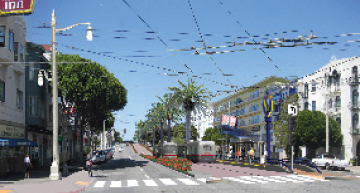Bus rapid transit design being finalized for Van Ness Avenue

BRT aims to achieve light-rail-like performance by running buses over a dedicated transitway. The buses will stop at stations with level boarding (no stairs) and fare prepayment. The draft EIR for the Van Ness BRT evaluates three transitways, each one stretching from Mission to Lombard. The least expensive to build would dedicate Van Ness Avenue’s outside lanes to bus use, although vehicles could cross the bus lanes to make right turns, parallel park, or pick up and discharge passengers. The more expensive alternatives would expropriate Van Ness’s median and two center lanes. One alternative would physically separate the transitway from vehicular traffic. Both would limit left turns from Van Ness into intersecting streets. The most extreme proposal would eliminate all left turns from Van Ness except for one at Lombard northbound and asinglelane at Broadway southbound.
Any one of these BRT designs will surely improve Muni service on Van Ness Avenue, but there are drawbacks to each of them as well. Buses will make fewer stops than they do today, which will make them less convenient. Two traffic lanes in each direction rather than three will likely increase congestion during rush hours and on Friday and Saturday nights. Center-running BRT designs reduce or virtually eliminate left turns from Van Ness. Drivers who currently use these turns will have to find other routes to their destinations – routes that will often traverse residential streets. Neighborhoods south of Lombard and west of Van Ness (including Golden Gate Valley, Cow Hollow and Pacific Heights) may be hit hard by such “trip diversions” on weekdays and weekend evenings.
After the public comment period on the draft EIR ends, unless widespread objection to any form of Van Ness BRT suddenly materializes and the public embraces the so-called “no build” alternative, one transitway will be selected as the “locally preferred alternative” and submitted to the Federal Transit Administration for funding. Despite recent changes in the political landscape, this project has a good chance of being approved. Construction could commence in 2012, and the buses could be running by the end of 2014. The Van Ness BRT project has been flying “under the radar” for years. Now is the time to become informed about it.
Information on the Van Ness BRT feasibility study and a project fact sheet with explanations of the proposed alternatives can be found online at www.vannessbrt.org or contact Rachel Hiatt, senior transportation planner, S.F. County Transportation Authority (415-522-4809, [email protected]).
The formal draft environmental impact analysis will be made available for public review and comment in spring 2011. The S.F. County Transportation Authority will publicize the analysis and its findings and solicit public feedback, but no specific date for publication was available at press time.
The Van Ness BRT Citizens Advisory Commission meets quarterly on the fourth Tuesday of the month at 100 Van Ness Avenue, 26th Floor. Meetings are open to the public and the next meeting is scheduled for Tuesday, April 12, 2011, from 5–7 p.m.


